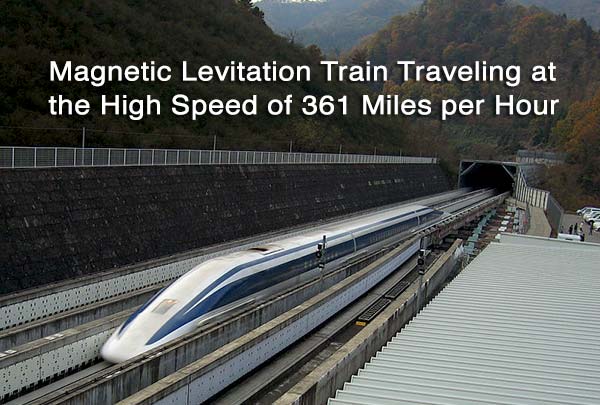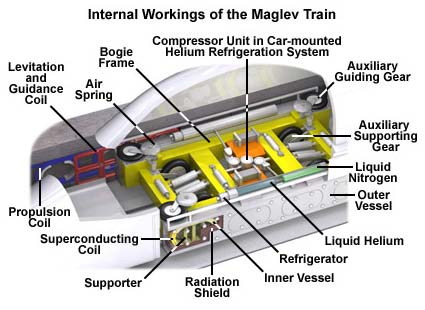Magnetic Levitation, or Maglev Trains: On Track with Superconductivity
If you have finished reading our primer on superconductivity, you may well be asking yourself, “OK, the science is very cool and impressive. But what is this all mean for me?”
Well, for one, it means that we, just like many other people in Japan, Germany, China, France and many other places will catchup to modern safe, clean and pollution free magnetic levitation technology and will be zipping across town or across country one day very soon, at 361 miles an hour, on a train with no wheels, that travels friction free and flies in mid air on its tracks.

Around the world, scientists and engineers have been developing maglev trains – trains that levitate above a magnetic field. Although there are systems (such as Germany’s Transrapid system) that use electromagnets rather than superconducting magnets, we’ll limit our explanation here to the type of train that harnesses superconductor technology. Such electrodynamic (suspension) systems (EDS) are currently in experimental use or under development in Japan and Florida.
Many believe this mode of transportation holds great promise and offers considerable advantages. The train cars are less expensive to build than traditional railway cars and are relatively quiet. The tracks take up less land. These trains use by far lot less energy than other types of transportation and do not pollute. And they put today’s “express” trains to shame, rocketing by at an average 250 to 361 mph that can climb much higher. Proponents say an underground maglev could one day shuttle you from the Atlantic to the Pacific in just one hour!
The beauty of maglevs is that they travel on air. The consequent elimination of friction means much greater efficiency. Just as electrons move more efficiently through a superconducting wire because there is no resistance, so, too, does a maglev travel more efficiently than a regular train because there is no friction between the wheels and the track, thanks to the Meissner Effect.
The train itself is equipped with several superconductors, while a series of electromagnetic coils run along the length of the track. When the train approaches these coils, the superconductors induce a current in them that works to both levitate the train several centimeters above the track and to center it between the guide rails.
PHYSICS FACTOID: According to Maglev 2000 of Florida Corporation, the company developing a maglev train for that state, their vehicle, per passenger mile, would cost one third as much as plane travel.
That’s a pretty neat trick, but it gets much neater once you get the train moving.
That’s achieved by a second series of electromagnetic coils, which run alongside the levitation/guidance coils. After the train reaches a certain speed, these propulsion coils kick into gear. They receive a constantly alternating electric current that changes the polarity of the coils in such a way that they are always arranged to push or to pull the on board superconducting magnets of the passing train. In essence it’s a motor – not a circular one, like the one in your car, but linear, running the length of the entire track. The beauty, though, is that only the coils that are in the vicinity of the moving train at any point in time need be engaged.

Beautiful, isn’t it?
That’s not the end of the line for potential applications for superconducting technology. A number of companies have been developing superconducting cables to carry electricity more efficiently, an application already in use in a number of markets.
http://www.magnet.fsu.edu/education/tutorials/magnetacademy/superconductivity101/index.html


